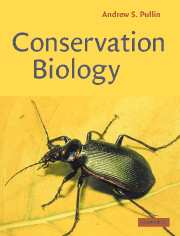Book contents
- Frontmatter
- Contents
- Preface
- Part 1
- Part 2
- Part 3
- Chapter 7 The rise of conservation biology
- Chapter 8 Selecting protected areas
- Chapter 9 Design and management of protected areas
- Chapter 10 Protecting species. I. In situ conservation
- Chapter 11 Protecting species. II. Ex situ conservation and reintroduction
- Chapter 12 Landscape scale conservation
- Chapter 13 Conserving the evolutionary process (a longer-term view of conservation)
- Chapter 14 Ecological restoration
- Chapter 15 Putting the science in to practice
- References
- Index
Chapter 14 - Ecological restoration
Published online by Cambridge University Press: 05 June 2012
- Frontmatter
- Contents
- Preface
- Part 1
- Part 2
- Part 3
- Chapter 7 The rise of conservation biology
- Chapter 8 Selecting protected areas
- Chapter 9 Design and management of protected areas
- Chapter 10 Protecting species. I. In situ conservation
- Chapter 11 Protecting species. II. Ex situ conservation and reintroduction
- Chapter 12 Landscape scale conservation
- Chapter 13 Conserving the evolutionary process (a longer-term view of conservation)
- Chapter 14 Ecological restoration
- Chapter 15 Putting the science in to practice
- References
- Index
Summary
Many natural areas have been partly destroyed or degraded through the direct or indirect action of mankind. However, this damage need not be total or permanent. To some extent habitats and ecosystems can be restored on a local basis provided that the materials (e.g. species) and expertise exist. Restoration is a positive process that can be used to great effect in conservation, but can also be misused to seduce us into inappropriate use of resources.
By reading this chapter students will gain an understanding of the aims and scope of ecological restoration, the variety of restoration projects and their challenges, together with the advantages and limitations of the concept.
Introduction
The rise of ecological restoration as a valuable process in conserving biological diversity has largely come about through the need to restore damaged and degraded land arising from agricultural and industrial activity. Early and groundbreaking work in the discipline has been made largely by scientists and land managers engaged in restoring large areas of heavily degraded land to something functional (e.g. Leopold 1949; Bradshaw 1983). As the discipline has matured, more searching questions about goals of restoration have been asked and definitions sought from the community or ecosystem perspective. The end users of this information are most commonly planners and developers, but increasingly ambitious conservation objectives are being set.
When we think of restoration, the repair of a painting may come to mind, and what wemay perceive of this is the act of returning the object to its pristine condition.
- Type
- Chapter
- Information
- Conservation Biology , pp. 284 - 304Publisher: Cambridge University PressPrint publication year: 2002

